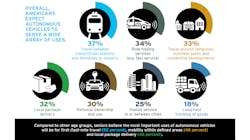All around the world, municipal governments are investing in a range of technologies to make their cities smarter, with the vision of delivering a better quality of life for residents while achieving greater efficiency and safety. Public transit agencies are playing an important role in these multi-faceted strategies, investing significantly in technologies and partnerships that will reshape mobility in the urban core and beyond.
At the heart of these efforts is a vision of “mobility as a service,” with residents planning and paying for trips (or shipping and receiving goods) seamlessly, across public and private assets, with ease. This is why we’re seeing new collaborations between transit agencies, ride-sharing and shipping companies, and even new micro-transit concepts such as Lime scooters.
This spirit of cooperation is extremely exciting. However, a major challenge in serving up these coordinated mobility assets will be to answer this question: How do we ensure that this new age of mobility serves everyone – regardless of their means or neighborhood? It’s a question that remains foremost in our minds as we make partnership and investment decisions.
Unfortunately, getting to the best answers is never simple. For example, on the surface electronic fare collection would seem to serve a broad spectrum of society. After all, according to the Pew Research Center, 67 percent of people earning under $30,000 – and even higher percentages of minority populations – owned a smartphone in 2018. However, that doesn’t mean that the smartphone users can readily access electronic fare systems. Millions have no bank accounts and, even if they do, they may never make it over hurdles such as bank verifications and app complexities.
Autonomous Seniors?
The closer we look at our communities, the more surprises we uncover. Last spring, an HNTB America THINKS survey asked 1,000 Americans* about the most likely uses of Autonomous Vehicles (AVs) down the road. About a third (37 percent) of respondents envisioned AVs for travel between transit stations and airport terminals – something that 52 percent of seniors (69+) envisioned. Seniors also were most likely to agree (46 percent versus 33 percent) that AVs could be used for mobility in residential areas and business parks. And, they were more likely to agree (46 percent versus 32 percent) that AVs would assist with local package delivery for all.
Such findings indicate that seniors, who far too often are portrayed as technology and risk-averse, actually have a strong belief in practical, daily benefits that will arise from exciting innovations, such as AVs and the future advent of seamless pay options. This news should be heartening for transit leaders who today grapple with the challenge of giving seniors affordable door-to-door mobility options.
Partnering for Insights
Achieving “Mobility for All” will require that we get much closer to the people who populate our cities, to understand what’s most important to them, how they access transportation today and how their lives could be improved through new, better or better-coordinated options. This means gathering a lot of data about people’s preferences through surveys and outreach, as well as through their behavior as captured through location and transactional data they provide voluntarily through their smartphones and other devices. This also means that transit agencies have the responsibility for recognizing the sensitivity of these data and securing the public’s privacy.
Other meaningful data can be acquired by proactively engaging community organizations whose missions overlap with those of transit agencies. Take public schools, for instance. They, too, are interested in advancing the public welfare and every day are involved in transporting children to and from their facilities. School officials can become allies by sharing (anonymized, protected) information about students’ household sizes, languages spoken, income level and other factors. This data can greatly enhance the agency’s targeting of services to those households and sets the stage for stronger relationships and potential synergies as they relate to transporting children across the city.
This same opportunity for service synergies exists between transit agencies and social services organizations. Many organizations provide transportation services to a wide range of people with special requirements, and their incurred costs can be very high. Paratransit or On-Demand Services partnerships in such circumstances can both ease cost pressures for these high-impact groups while increasing visibility and utilization of public paratransit services.
Serving Everyone, Everywhere
By striving to meet the mobility needs of all potential riders in the years ahead, transit agencies will ensure their continuing viability in a world of unforeseeable transportation innovations (case in point: the sudden rise of scooter-sharing). When we collaborate across the public and private sectors with a shared goal of improving mobility for everyone – in every neighborhood, regardless of their means – we have the opportunity to make transit the high-efficiency backbone of a strong and dynamic urban transportation system.
Kimberly Slaughter serves as national transit/rail market sector leader and senior vice president for HNTB Corp.
* HNTB’s America THINKS survey, The Road to Autonomous Vehicles – 2018, polled a random nationwide sample of 1,010 Americans, ages 18+, between April 27 and April 30, 2018. It was conducted by Russell Research using an email-invitation and online survey.
About the Author

Kimberly Slaughter
National Transit/Rail Market Sector Leader
Kimberly Slaughter serves as national transit/rail market sector leader and senior vice president for HNTB. Her role includes collaborating with HNTB’s regional and office leadership on strategic planning and implementation, industry representation, business development, service delivery and client satisfaction.
